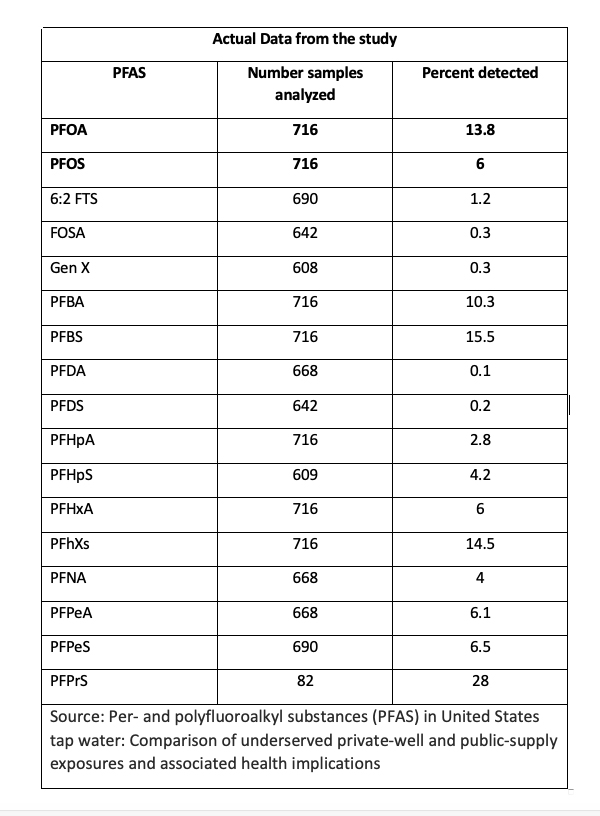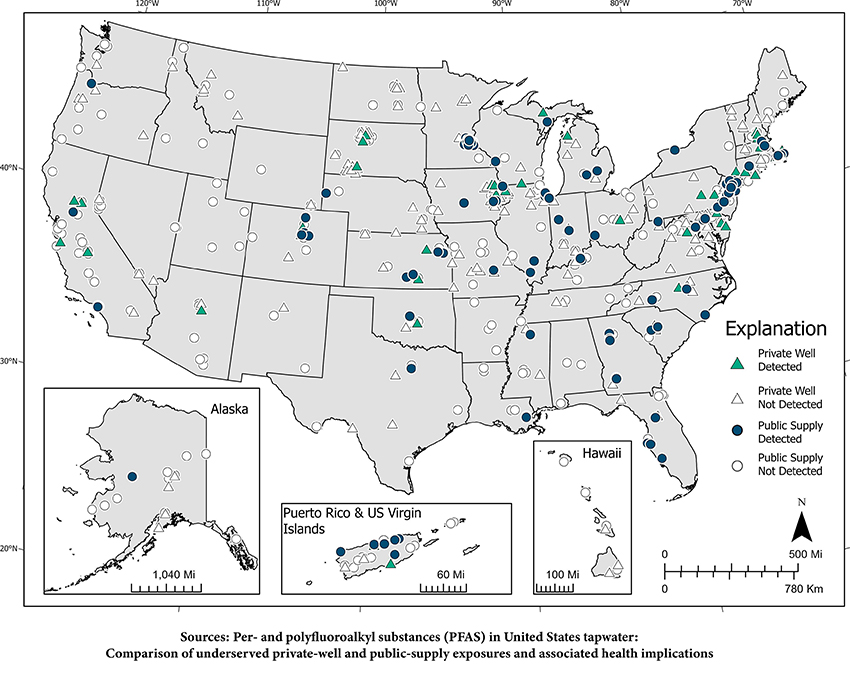First, a little background on polyfluoroalkyl substances (PFAS). PFAS are a large group of chemicals characterized by linked chains of carbon and fluorine. PFOA and PFOS are the best-known PFAS and are the only two with suggestive health effects data. Both compounds have been found in groundwater and drinking water supplies, primarily from their use in fire-fighting foams found at military bases and airports where fire-fighting training occurs.
The EPA proposed an enforceable drinking water regulation for PFOA and PFOS in March 2023, choosing an allowable level set so low, 4 parts per trillion, that it is below the level many laboratories can detect.
The US Geological Services (USGS) study
The study tested for the presence of 32 PFAS in tap water from 716 locations (269 private wells and 447 public water supplies) from 2016-2021. They found 17 in one or more samples. The following shows where the PFAS were detected across the US:
According to the study
- The number of individual PFAS observed ranged from 1 to 9 (median of 2)
- The corresponding cumulative concentrations, the sum of detected PFAS, ranged from 0.348 to 0.346 parts per trillion – a reminder, the new proposed standard is 4 parts per trillion
The study concluded that
“Modeled results indicate that on average at least one PFAS is detected in about 45% of US drinking water samples. Benchmark screening approaches indicated potential human exposure risk was dominated by PFOA and PFOS.”
But the USGS study has some important caveats and shortcomings. Let’s break them down.
A National Study
The USGS press release, and the article itself, give the impression that this is a groundbreaking new study with significant findings. However, this is neither new nor comprehensive. The USGS cobbled together results from an EPA study of 26 samples from 2016, three Colorado School of Mines studies of 82 samples from 2017 and 2018, and six USGS studies of 608 samples from 2019-2021.
The number of samples in this study is well below the number needed to do a national study of the occurrence in drinking water. The Safe Drinking Water Act requires the EPA to conduct a national survey of unregulated contaminants in drinking water every five years. Their last completed study, the Fourth Unregulated Contaminant Monitoring Rule, carried out between 2018 and 2020, involved over 37,000 samples. The EPA’s Fifth Unregulated Contaminant Monitoring Rule is currently underway and is collecting samples on 30 chemical contaminants, including 29 PFAS. When this study is complete in 2025, we will have a much better understanding of the actual occurrence of PFAS in drinking water.
Since the USGS study was quite small (less than 2% of the 37,000 samples done by EPA), they could not reach conclusions on PFAS’ national occurrence. Instead, they used models to estimate the national occurrence. These modeled results, not actual data, were the basis for the headlines that PFAS was found in 45% of the nation’s drinking water. The majority of samples did not contain PFAS, with PFOA not detected in 86.2% of the samples and PFOS not detected in 94.0% of the samples. Quite a difference from the USGS’s opening statement, that “at least 45% of the nation’s tap water is estimated to have one or more type of the chemicals known as PFAS.” The USGS buries the fact that these were modeled results based on limited data.
Concentrations of PFAS
The study focused on the number of PFAS detected at each site, not their concentrations. Buried deep within the supplemental tables was data showing that PFOA concentrations ranged from a minimum of 1.13 parts per trillion to 33.2 parts per trillion with a mean of 5.6 parts per trillion.
Health Conclusions
The study used two methods as the basis for their health conclusions:
- The sum of Exposure Activity Ratio (∑EAR): Ratio of the detected concentration of a chemical to the activity concentration detected in studies in cells. According to the article, none of the samples exceeded a value of 1, indicating a health concern; however, 65 samples exceeded a value of 0.001, a precautionary screening level signifying potential concern.
The EPA developed the ∑EAR method to highlight their ToxCast database, which contains information on the effects of approximately 9000 chemicals in cells. The ∑EAR method is not a generally accepted method of measuring toxicity, and the screening level “representing a level of potential concern” is purely arbitrary and not based on science.
- The sum of Toxicity Quotients (∑TQ): Ratio of the detected concentration of a chemical to its corresponding health benchmark (safe level). Unlike the ∑EAR method, the ∑TQ is a more accepted method of measuring toxicity. However, the results of this method are dependent on the health benchmarks chosen for each chemical.
The article used EPA’s interim health advisories as its PFOA and PFOS health benchmark for PFOA and PFOS, concluding there was a “high probability of aggregated risk when considering exposures to all observed PFAS with an available benchmark.” But there are few benchmarks available for PFAS other than PFOA or PFOS, the EPA’s health advisories for PFOA and PFOS, levels that are more than 100,000 lower than the health benchmarks from other countries.
It is difficult to find credibility in the USGS conclusions. Historically, the USGS is known for complete and well-documented research. This study has some significant shortcomings, and the USGS has done a grave disservice by publishing it without stating its significant limitations. Part of why this is so disappointing is that the USGS could have waited for the results from EPA’s current national study, the Fifth Unregulated Contaminant Monitoring Rule, to reach conclusions on the national occurrence of PFAS.
It may be that the USGS was trying to join the government bandwagon in support of EPA’s controversial PFAS regulation; however, offering limited and flawed data is not the answer. We have a right to expect better.
[1] 
Sources: Per- and polyfluoroalkyl substances (PFAS) in United States tapwater: Comparison of underserved private-well and public-supply exposures and associated health implications Environment International DOI: 10.1016/j.envint.2023.108033
Tap Water Study Detects PFAS ‘forever chemicals’ across the US USGS News Release





